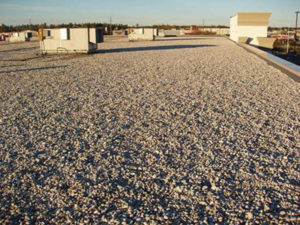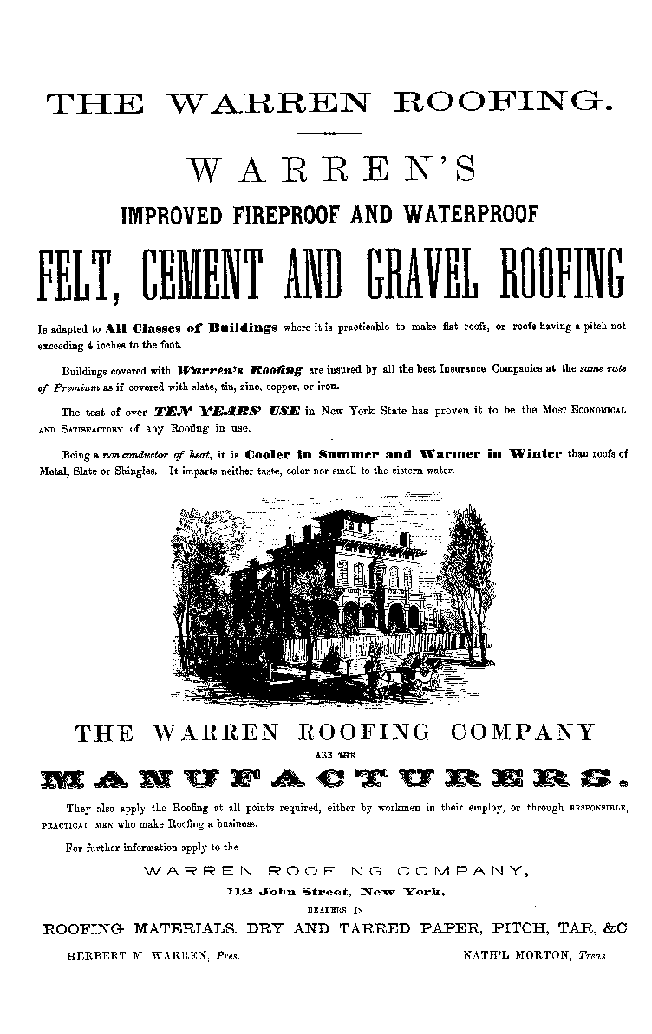In the early to mid-1800’s, urban construction was on the up rise, and it became abundantly apparent that a new kind of roofing material was needed. This was particularly true for row houses, which often times had low slope roofs. Common roofing materials of the time consisted of wood or metal roofing systems, which with the many pieces and seams, did not work correctly at such a low slope. A roofing system that was continuous and nearly seamless was needed.
During this time, a new industry of man-made roofing material emerged. No longer were people only using natural products found from trees or mining metal, but were now beginning to develop material made from many different elements. As early as the 1840’s, inventors and builders had been experimenting with ways to improve the current roofing systems if the day. The concept was to cover the roofs with water repelling liquid saturated rolls of paper or textiles, which were then layered with crushed granules. Most people had the same concept, but the materials used varied widely. Felt, flax, and canvas were examples of textiles used, while pine pitch, mineral tar, and fish oil were examples of the water repelling saturates. Granules could have been sand, ground shells, marble dust, or china clay.
In Cincinnati 1847, Samuel and Cyrus Warren discovered that coal tar could be used as an adhesive for what we consider built up roofs today. At the time, street lamps were fueled by coal, which left behind a sticky waste that the gas companies had to pay to remove. After discovering that this waste product could be used for roofing material, the Warrens struck deals with the local gas companies to remove the coal tar, and some companies would even pay them.
Once other uses had been found for coal tar, gas companies began to charge for the byproduct. The Warrens decided to look for an alternative, cheaper product that would work as well or better than coal tar. What they found was naturally occurring asphalt and the largest source of such was in Pitch Lake in Trinidad, relatively close on a global scale. During the 1880’s and 1890’s, the S.M. and C.M. Warren Roofing Company mixed petroleum tar, a byproduct of the oil distilling industry, with the asphalt to develop roofing materials, roof pitch, and paving products. By the turn of the century, cotton based felt was used for the textile base and crushed gravel as the top layer. This was the predecessor of asphalt shingles.
 The Warren Roofing Company not only contracted their roofing services, but also sold their composition roofing products as well. They would lay rolls of the composition roofing, nailing the edge down and lap over with the next sheet. The material would either be saturated at a manufacturing plant or on site. After installing the composition material, it would be topped with crushed gravel. Eventually, in the early 1900’s, this system would consist of laying multiple layers of sheets, mopping each layer with hot liquid asphalt, and then coating the top with crushed gravel. This was and still is called hot mop or built up roofs.
The Warren Roofing Company not only contracted their roofing services, but also sold their composition roofing products as well. They would lay rolls of the composition roofing, nailing the edge down and lap over with the next sheet. The material would either be saturated at a manufacturing plant or on site. After installing the composition material, it would be topped with crushed gravel. Eventually, in the early 1900’s, this system would consist of laying multiple layers of sheets, mopping each layer with hot liquid asphalt, and then coating the top with crushed gravel. This was and still is called hot mop or built up roofs.
This early form of composition roofing led way to asphalt shingles, in their many different shapes and sizes, and to build up roofs, still used today. In the early 1900’s, rolled material was cut to make individual shingle tabs. Of course, cutting each tab is time consuming, so a way to cut the membrane by machine was developed. This allowed manufactures to have uniform sizes and shapes to add variety and styles to sloped roofs.



Comments are closed.